
Documentation
EL3356-00x0
1 Channel Input Terminal, Precise Resistor Bridge (strain
gauge)
4.0
2020-02.26
Version:
Date:


Table of contents
EL3356-00x0 3Version: 4.0
Table of contents
1 Foreword ....................................................................................................................................................7
1.1 Pecise Resistor Bridge - Product Overview.......................................................................................7
1.2 Notes on the documentation..............................................................................................................7
1.3 Safety instructions .............................................................................................................................9
1.4 Documentation issue status ............................................................................................................10
1.5 Version identification of EtherCAT devices .....................................................................................11
1.5.1 Beckhoff Identification Code (BIC)................................................................................... 13
2 Product overview.....................................................................................................................................15
2.1 EL3356, EL3356-00x0 - Introduction...............................................................................................15
2.2 EL3356-00x0 - Technical data.........................................................................................................17
2.3 Basic principles of strain gauge technology ....................................................................................18
2.4 Start .................................................................................................................................................24
3 Basics communication ...........................................................................................................................25
3.1 EtherCAT basics..............................................................................................................................25
3.2 EtherCAT cabling – wire-bound.......................................................................................................25
3.3 General notes for setting the watchdog...........................................................................................26
3.4 EtherCAT State Machine.................................................................................................................28
3.5 CoE Interface...................................................................................................................................30
3.6 Distributed Clock .............................................................................................................................35
4 Mounting and wiring................................................................................................................................36
4.1 Instructions for ESD protection........................................................................................................36
4.2 Installation on mounting rails ...........................................................................................................36
4.3 Installation instructions for enhanced mechanical load capacity .....................................................39
4.4 Connection ......................................................................................................................................40
4.4.1 Connection system .......................................................................................................... 40
4.4.2 Wiring............................................................................................................................... 42
4.4.3 Shielding .......................................................................................................................... 43
4.5 Installation positions ........................................................................................................................43
4.6 Positioning of passive Terminals .....................................................................................................46
4.7 ATEX - Special conditions (standard temperature range) ...............................................................47
4.8 ATEX Documentation ......................................................................................................................48
4.9 UL notice .........................................................................................................................................48
4.10 EL3356 - LEDs ................................................................................................................................49
4.11 EL3356 - Connection.......................................................................................................................49
5 Commissioning........................................................................................................................................52
5.1 TwinCAT Quick Start .......................................................................................................................52
5.1.1 TwinCAT2 ....................................................................................................................... 55
5.1.2 TwinCAT 3 ....................................................................................................................... 65
5.2 TwinCAT Development Environment ..............................................................................................77
5.2.1 Installation of the TwinCAT real-time driver..................................................................... 77
5.2.2 Notes regarding ESI device description........................................................................... 83
5.2.3 TwinCAT ESI Updater ..................................................................................................... 87
5.2.4 Distinction between Online and Offline............................................................................ 87

Table of contents
EL3356-00x04 Version: 4.0
5.2.5 OFFLINE configuration creation ...................................................................................... 88
5.2.6 ONLINE configuration creation ........................................................................................ 93
5.2.7 EtherCAT subscriber configuration................................................................................ 101
5.3 General Notes - EtherCAT Slave Application................................................................................110
5.4 Quick start......................................................................................................................................119
5.5 Basic function principles ................................................................................................................120
5.5.1 General notes ................................................................................................................ 121
5.5.2 Block diagram ................................................................................................................ 123
5.5.3 Averager ........................................................................................................................ 123
5.5.4 Software filter................................................................................................................. 123
5.5.5 Dynamic filter ................................................................................................................. 126
5.5.6 Calculating the weight.................................................................................................... 127
5.5.7 Conversion mode........................................................................................................... 128
5.6 Application notes ...........................................................................................................................130
5.6.1 Symmetric reference potential ....................................................................................... 130
5.6.2 Wiring fail indication....................................................................................................... 130
5.6.3 InputFreeze.................................................................................................................... 130
5.6.4 Gravity adaptation.......................................................................................................... 131
5.6.5 Idling recognition............................................................................................................ 132
5.6.6 Official calibration capability .......................................................................................... 132
5.7 Calibration and compensation .......................................................................................................133
5.7.1 Sensor calibration .......................................................................................................... 133
5.7.2 Self-calibration ............................................................................................................... 135
5.7.3 Taring............................................................................................................................. 136
5.7.4 Overview of commands ................................................................................................. 137
5.8 Notices on analog specifications ...................................................................................................137
5.8.1 Full scale value (FSV).................................................................................................... 137
5.8.2 Measuring error/ measurement deviation ...................................................................... 138
5.8.3 Temperature coefficient tK [ppm/K] ............................................................................... 138
5.8.4 Single-ended/differential typification .............................................................................. 139
5.8.5 Common-mode voltage and reference ground (based on differential inputs)................ 144
5.8.6 Dielectric strength .......................................................................................................... 144
5.8.7 Temporal aspects of analog/digital conversion.............................................................. 145
5.9 Voltage measurement ...................................................................................................................148
5.10 Distributed Clocks mode (EL3356-0010, EL3356-0090 only) .......................................................149
5.11 Process data..................................................................................................................................151
5.11.1 Selection of process data .............................................................................................. 151
5.11.2 Default process image................................................................................................... 153
5.11.3 Variants Predefined PDO .............................................................................................. 154
5.11.4 Distributed Clocks.......................................................................................................... 157
5.11.5 Sync Manager................................................................................................................ 158
5.12 TwinSAFE SC................................................................................................................................159
5.12.1 TwinSAFE SC - operating principle ............................................................................... 159
5.12.2 TwinSAFE SC - configuration........................................................................................ 159
5.13 EL3356-0090 - TwinSAFE SC process data ................................................................................163
5.14 EL3356, EL3356-00x0 - Object description and parameterization ................................................163

Table of contents
EL3356-00x0 5Version: 4.0
5.14.1 Restore object................................................................................................................ 164
5.14.2 Configuration data ......................................................................................................... 165
5.14.3 Command object............................................................................................................ 167
5.14.4 Input data....................................................................................................................... 167
5.14.5 Output data.................................................................................................................... 168
5.14.6 Information / diagnostic data.......................................................................................... 168
5.14.7 Vendor configuration data (device-specific)................................................................... 169
5.14.8 Standard objects............................................................................................................ 169
5.15 EL3356-0090 - Objekte TwinSAFE Single Channel ......................................................................178
5.16 Sample Program............................................................................................................................179
6 Appendix ................................................................................................................................................183
6.1 EtherCAT AL Status Codes...........................................................................................................183
6.2 Firmware compatibility...................................................................................................................183
6.3 Firmware Update EL/ES/EM/ELM/EPxxxx ....................................................................................184
6.3.1 Device description ESI file/XML..................................................................................... 185
6.3.2 Firmware explanation .................................................................................................... 188
6.3.3 Updating controller firmware *.efw................................................................................. 189
6.3.4 FPGA firmware *.rbf....................................................................................................... 191
6.3.5 Simultaneous updating of several EtherCAT devices.................................................... 195
6.4 Restoring the delivery state ...........................................................................................................196
6.5 Support and Service ......................................................................................................................197

Table of contents
EL3356-00x06 Version: 4.0

Foreword
EL3356-00x0 7Version: 4.0
1 Foreword
1.1 Pecise Resistor Bridge - Product Overview
EL3356 [}15]
1-channel precise load cell analysis (resistor bridge), 16bit
EL3356-0010 [}15]
1-channel precise load cell analysis (resistor bridge), 24bit
EL3356-0090 [}15]
1-channel precise load cell analysis (resistor bridge), 24bit, (TwinSAFE Single
Channel)
1.2 Notes on the documentation
Intended audience
This description is only intended for the use of trained specialists in control and automation engineering who
are familiar with the applicable national standards.
It is essential that the documentation and the following notes and explanations are followed when installing
and commissioning these components.
It is the duty of the technical personnel to use the documentation published at the respective time of each
installation and commissioning.
The responsible staff must ensure that the application or use of the products described satisfy all the
requirements for safety, including all the relevant laws, regulations, guidelines and standards.
Disclaimer
The documentation has been prepared with care. The products described are, however, constantly under
development.
We reserve the right to revise and change the documentation at any time and without prior announcement.
No claims for the modification of products that have already been supplied may be made on the basis of the
data, diagrams and descriptions in this documentation.
Trademarks
Beckhoff
®
, TwinCAT
®
, EtherCAT
®
, EtherCATG
®
, EtherCATG10
®
, EtherCATP
®
, SafetyoverEtherCAT
®
,
TwinSAFE
®
, XFC
®
, XTS
®
and XPlanar
®
are registered trademarks of and licensed by Beckhoff Automation
GmbH. Other designations used in this publication may be trademarks whose use by third parties for their
own purposes could violate the rights of the owners.
Patent Pending
The EtherCAT Technology is covered, including but not limited to the following patent applications and
patents: EP1590927, EP1789857, EP1456722, EP2137893, DE102015105702 with corresponding
applications or registrations in various other countries.
EtherCAT
®
is registered trademark and patented technology, licensed by Beckhoff Automation GmbH,
Germany.

Foreword
EL3356-00x08 Version: 4.0
Copyright
© Beckhoff Automation GmbH & Co. KG, Germany.
The reproduction, distribution and utilization of this document as well as the communication of its contents to
others without express authorization are prohibited.
Offenders will be held liable for the payment of damages. All rights reserved in the event of the grant of a
patent, utility model or design.

Foreword
EL3356-00x0 9Version: 4.0
1.3 Safety instructions
Safety regulations
Please note the following safety instructions and explanations!
Product-specific safety instructions can be found on following pages or in the areas mounting, wiring,
commissioning etc.
Exclusion of liability
All the components are supplied in particular hardware and software configurations appropriate for the
application. Modifications to hardware or software configurations other than those described in the
documentation are not permitted, and nullify the liability of Beckhoff Automation GmbH & Co. KG.
Personnel qualification
This description is only intended for trained specialists in control, automation and drive engineering who are
familiar with the applicable national standards.
Description of instructions
In this documentation the following instructions are used.
These instructions must be read carefully and followed without fail!
DANGER
Serious risk of injury!
Failure to follow this safety instruction directly endangers the life and health of persons.
WARNING
Risk of injury!
Failure to follow this safety instruction endangers the life and health of persons.
CAUTION
Personal injuries!
Failure to follow this safety instruction can lead to injuries to persons.
NOTE
Damage to environment/equipment or data loss
Failure to follow this instruction can lead to environmental damage, equipment damage or data loss.
Tip or pointer
This symbol indicates information that contributes to better understanding.

Foreword
EL3356-00x010 Version: 4.0
1.4 Documentation issue status
Version Comment
4.0 - Update revision status
- Update structure
- Update revision status
3.9 - Basic principles of strain gauge technology
- Update structure
3.8 - Basic principles of strain gauge technology
- Update revision status
- Update structure
3.7 - Update chapter "Quick start"
- Update revision status
3.6 - Correction for connection technology in figures "EL3356-xxxx" and "LEDs and pin assignment EL3356, EL3356-00x0"
- Update chapter "Technical data"
- Update chapter "TwinSAFE SC"
- Structural update
- Update revision status
3.5 - EL3356-0090 added
- Update chapter "Connection technology" -> "connection"
- Structure update
- Update revision status
3.4 - Update chapter "Technical data"
- Update chapter "Basic function principles"
- Structure update
3.3 - Update chapter "Technical data"
- Note on ESD protection added
- Update chapter "Notes on analog specifications"
3.2 - Update chapter "Notes on the documentation"
- Correction in technical data
- Chapter "TwinCAT Quick-Start" added
- Update revision status
3.1 - Download link for sample program corrected
- Addenda chapter "Notes on analog specifications"
3.0 - First publication in PDF format
- Structure update
- Corrections in chapters "Voltage measurement" and "Sync Manager"
2.1 Update chapter "Technical data"
- Update chapter "Object description"
- Structure update
- Update revision status
2.0 - Update chapter "Technical data"
- Addenda chapter "Installation instructions for enhanced mechanical load capacity"
- Structure update
- Update revision status
1.9 - Update chapter "Basic function principles"
- Update chapter "Technical data"
- Update chapter "Process data"
- Structure update
1.8 - Update chapter "Basic function principles"
1.7 - Update chapter "Basic function principles" and "Object description"
1.6 - Update Technical data
1.5 - Addenda in chapter "Basic function principles"
1.4 - Addenda in chapter "Basic function principles", "Technical data"
1.3 - Addenda in chapter "Object description", "LEDs and connection"
1.2 - Addenda chapter "Calibration"
1.1 - Addenda in chapter "Basics strain gauge technology"
1.0 - Addenda and 1st public issue
0.1 - 0.5 - Provisional documentation for EL3356

Foreword
EL3356-00x0 11Version: 4.0
1.5 Version identification of EtherCAT devices
Designation
A Beckhoff EtherCAT device has a 14-digit designation, made up of
• family key
• type
• version
• revision
Example Family Type Version Revision
EL3314-0000-0016 EL terminal
(12 mm, non-
pluggable connection
level)
3314 (4-channel thermocouple
terminal)
0000 (basic type) 0016
ES3602-0010-0017 ES terminal
(12 mm, pluggable
connection level)
3602 (2-channel voltage
measurement)
0010 (high-
precision version)
0017
CU2008-0000-0000 CU device 2008 (8-port fast ethernet switch) 0000 (basic type) 0000
Notes
• The elements mentioned above result in the technical designation. EL3314-0000-0016 is used in the
example below.
• EL3314-0000 is the order identifier, in the case of “-0000” usually abbreviated to EL3314. “-0016” is the
EtherCAT revision.
• The order identifier is made up of
- family key (EL, EP, CU, ES, KL, CX, etc.)
- type (3314)
- version (-0000)
• The revision -0016 shows the technical progress, such as the extension of features with regard to the
EtherCAT communication, and is managed by Beckhoff.
In principle, a device with a higher revision can replace a device with a lower revision, unless specified
otherwise, e.g. in the documentation.
Associated and synonymous with each revision there is usually a description (ESI, EtherCAT Slave
Information) in the form of an XML file, which is available for download from the Beckhoff web site.
From 2014/01 the revision is shown on the outside of the IP20 terminals, see Fig. “EL5021 EL terminal,
standard IP20 IO device with batch number and revision ID (since 2014/01)”.
• The type, version and revision are read as decimal numbers, even if they are technically saved in
hexadecimal.
Identification number
Beckhoff EtherCAT devices from the different lines have different kinds of identification numbers:
Production lot/batch number/serial number/date code/D number
The serial number for Beckhoff IO devices is usually the 8-digit number printed on the device or on a sticker.
The serial number indicates the configuration in delivery state and therefore refers to a whole production
batch, without distinguishing the individual modules of a batch.
Structure of the serial number: KKYYFFHH
KK - week of production (CW, calendar week)
YY - year of production
FF - firmware version
HH - hardware version

Foreword
EL3356-00x012 Version: 4.0
Example with
Ser. no.: 12063A02: 12 - production week 12 06 - production year 2006 3A - firmware version 3A 02 -
hardware version 02
Unique serial number/ID, ID number
In addition, in some series each individual module has its own unique serial number.
See also the further documentation in the area
• IP67: EtherCAT Box
• Safety: TwinSafe
• Terminals with factory calibration certificate and other measuring terminals
Examples of markings
Fig.1: EL5021 EL terminal, standard IP20 IO device with serial/ batch number and revision ID (since
2014/01)
Fig.2: EK1100 EtherCAT coupler, standard IP20 IO device with serial/ batch number
Fig.3: EL3202-0020 with serial/ batch number 26131006 and unique ID-number 204418

Foreword
EL3356-00x0 13Version: 4.0
1.5.1 Beckhoff Identification Code (BIC)
The Beckhoff Identification Code (BIC) is increasingly being applied to Beckhoff products to uniquely identify
the product. The BIC is represented as a Data Matrix Code (DMC, code scheme ECC200), the content is
based on the ANSI standard MH10.8.2-2016.
Fig.4: BIC as data matrix code (DMC, code scheme ECC200)
The BIC will be introduced step by step across all product groups.
Depending on the product, it can be found in the following places:
• on the packaging unit
• directly on the product (if space suffices)
• on the packaging unit and the product
The BIC is machine-readable and contains information that can also be used by the customer for handling
and product management.
Each piece of information can be uniquely identified using the so-called data identifier
(ANSIMH10.8.2-2016). The data identifier is followed by a character string. Both together have a maximum
length according to the table below. If the information is shorter, spaces are added to it. The data under
positions 1 to 4 are always available.
The following information is contained:

Foreword
EL3356-00x014 Version: 4.0
Item
no.
Type of
information
Explanation Data
identifier
Number of digits
incl. data identifier
Example
1 Beckhoff order
number
Beckhoff order number 1P 8 1P072222
2 Beckhoff Traceability
Number (BTN)
Unique serial number,
see note below
S 12 SBTNk4p562d7
3 Article description Beckhoff article
description, e.g.
EL1008
1K 32 1KEL1809
4 Quantity Quantity in packaging
unit, e.g. 1, 10, etc.
Q 6 Q1
5 Batch number Optional: Year and week
of production
2P 14 2P401503180016
6 ID/serial number Optional: Present-day
serial number system,
e.g. with safety products
51S 12 51S678294104
7 Variant number Optional: Product variant
number on the basis of
standard products
30P 32 30PF971, 2*K183
...
Further types of information and data identifiers are used by Beckhoff and serve internal processes.
Structure of the BIC
Example of composite information from item 1 to 4 and 6. The data identifiers are marked in red for better
display:
BTN
An important component of the BIC is the Beckhoff Traceability Number (BTN, item no.2). The BTN is a
unique serial number consisting of eight characters that will replace all other serial number systems at
Beckhoff in the long term (e.g. batch designations on IO components, previous serial number range for
safety products, etc.). The BTN will also be introduced step by step, so it may happen that the BTN is not yet
coded in the BIC.
NOTE
This information has been carefully prepared. However, the procedure described is constantly being further
developed. We reserve the right to revise and change procedures and documentation at any time and with-
out prior notice. No claims for changes can be made from the information, illustrations and descriptions in
this information.

Product overview
EL3356-00x0 15Version: 4.0
2 Product overview
2.1 EL3356, EL3356-00x0 - Introduction
EL3356, EL3356-0010
Fig.5: EL3356
1 channel precise resistor bridge analysis
The EL3356 or EL3356-0010 analog input terminal enables the direct connection of a resistor bridge (strain
gauge) or a load cell using a 4 or 6-wire connection technique. The ratio of the bridge voltage U
D
to the
supply voltage U
REF
is determined with high precision in the input circuit and the final load value is calculated
as a process value on the basis of the settings in the terminal. No further calculations are necessary in the
PLC/controller.
The terminal family has the following features in order to meet as many requirements as possible:
• low measuring error of < ±0.01% (see Technical data [}17])
• High resolution: 16-bit (EL3356) or 24-bit (EL3356-0010)
• fast measuring cycles: 10ms (EL3356) or 100µs (EL3356-0010)
• automatic self-calibration of the circuit (can be deactivated)
• adapted to synchronization via Distributed Clocks (EL3356-0010 only)
• manual input of the load cell characteristic values according to the load cell certificate (theoretical
calibration) or automatic determination by means of calibration procedure
• Tare function
• Special functions for highly dynamic weighing: dynamic filter adaptation, mode change and input freeze
Thus slow weighings can be performed with high precision using the EL3356. The EL3356-0010 is
particularly suitable for the fast and precise monitoring of torque or vibration sensors.
The EL3356/EL3356-0010 are not stand-alone scales; they are to be used only in conjunction with a PLC/
controller.

Product overview
EL3356-00x016 Version: 4.0
EL3356-0090
Fig.6: EL3356-0090
In addition to the full functionality of the EL3356-0010, the EL3356-0090 supports TwinSAFE SC (Single
Channel) technology. This enables the use of standard signals for safety tasks in any networks of fieldbuses.
Quick links
Basic principles of strain gauge technology [}18]
Basic function principles [}120]
QuickStart [}119]
EL3356, EL3356-00x0 - Object description and parameterization [}163]
EL3356-0090 - Objects TwinSAFE single Channel [}178]
EL3356-0090 - TwinSAFE SC process data [}163]

Product overview
EL3356-00x0 17Version: 4.0
2.2 EL3356-00x0 - Technical data
Technical data EL3356 EL3356-0010 EL3356-0090
Number of analog inputs 2, for 1 bridge circuit (full bridge)
Resolution 16bits, 32bit display 24bits, 32bit display
Conversion rate 100..4sps (samples per second)
(10..250ms conversion time)
10,000sps.. 4sps (0.1...250ms conversion time)
Distributed Clocks no Yes
switchable modes no yes (2)
Measuring error <±0.01% for the calculated load value
based on the load end value with 12V power supply and 24mV bridge voltage (therefore
nominal characteristic value for SG: 2mV/V), self-calibration active, 50Hz filter active
Measuring range U
d
max. -27mV ... +27mV typical (see note on voltage measurement [}148])
recommended: -25mV ... +25mV rated voltage
Measuring range U
ref
max. -13.8V ... +13.8V typical (see note on voltage measurement [}148])
recommended: -12V to +12V rated voltage
recommended supply voltage: 10V via power supply terminal EL9510 or 12V via
EL9512
Note the information provided by the sensor manufacturer!
Supported nominal characteristic values any, resolution of the parameter: 0.01µV/V
recommended: 0.5..4mV/V
Min. strain gauge resistance depending on external supply; parallel operation of strain gauge only recommended with
suitable strain gauge
Filter (hardware) 10kHz low-pass (-3 dB, see filter notes)
Filter (software) preset 50Hz,
configurable: 50/60Hz FIR notch filter, IIR low-pass
4x averager
Internal resistance > 200kΩ (U
ref
), > 1MΩ (U
d
)
Special features auto-calibration auto-calibration,
TwinSAFE SC
Power supply for the electronics via the E-bus
Current consumption via E-bus typ. 210mA typ. 280mA
Current consumption power contacts depending on strain gauge supply, min. 1mA
Electrical isolation 500V (E-bus/signal voltage)
Configuration via EtherCAT master/CoE
MTBF (+55 °C) - >780,000h
Weight approx. 60g
Permissible ambient temperature range dur-
ing operation
0°C ... + 55°C
Permissible ambient temperature range dur-
ing storage
-25°C ... + 85°C
Permissible relative air humidity 95%, no condensation
Dimensions (WxHxD) approx. 15mm x 100mm x 70mm (width aligned: 12mm)
Mounting [}36]
on 35mm mounting rail according to EN60715
Vibration/shock resistance conforms to EN60068-2-6 / EN60068-2-27,
see also installation instructions for terminals with increased
mechanical load capacity [}39]
conforms to EN60068-2-6 /
EN60068-2-27
EMC immunity/emission conforms to EN61000-6-2 / EN61000-6-4
Protection class IP20
Installation position variable
Approvals CE
cULus [}48]
ATEX [}47]
IECEx

Product overview
EL3356-00x018 Version: 4.0
2.3 Basic principles of strain gauge technology
Basic information on the technological field of strain gauges/load cells as metrological instruments is to be
given below. The information is of general nature; it is up to the user to check the extent to which it applies to
his application.
• Strain gauges serve either to directly measure the static (0 to a few Hz) or dynamic (up to several KHz)
elongations, compressions or torsions of a body by being directly fixed to it, or to measure various
forces or movements as part of a sensor (e.g. load cells/force transducers, displacement sensor,
vibration sensors).
• In the case of the optical strain gauge (e.g. Bragg grating), an application of force causes a
proportional change in the optical characteristics of a fiber used as a sensor. Light with a certain
wavelength is fed into the sensor. Depending upon the deformation of the grating, which is laser-cut
into the sensor, due to the mechanical load, part of the light is reflected and evaluated using a suitable
measuring transducer (interrogator).
The commonest principle in the industrial environment is the electrical strain gauge. There are many
common terms for this type of sensor: load cell, weighbridge, etc.
Structure of electrical strain gauges
A strain gauge consists of a carrier material (e.g. stretchable plastic film) with an applied metal film from
which a lattice of electrically conductive resistive material is worked in very different geometrical forms,
depending on the requirements.
Fig.7: Strain gauge
This utilizes a behavior whereby, for example in the case of strain, the length of a metallic resistance network
increases and its diameter decreases, as a result of which its electrical resistance increases proportionally.
ΔR/R = k*ε
ε = Δl/l thereby corresponds to the elongation; the strain sensitivity is called the k-factor. This also gives rise
to the typical track layout inside the strain gauge: the resistor track or course is laid in a meandering pattern
in order to expose the longest possible length to the strain.
Example
The elongation ε = 0.1% of a strain gauge with k-factor 2 causes an increase in the resistance of 0.2%.
Typical resistive materials are constantan (k~2) or platinum tungsten (92PT, 8W with k ~4). In the case of
semiconductor strain gauges a silicon structure is glued to a carrier material. The conductivity is changed
primarily by deformation of the crystal lattice (piezo-resistive effect); k-factors of up to 200 can be achieved.
Measurement of signals
The change in resistance of an individual strain gauge can be determined in principle by resistance
measurement (current/voltage measurement) using a 2/3/4-wire measurement technique.
Usually 1/2/4 strain gauges are arranged in a Wheatstone bridge (-> quarter/half/full bridge); the nominal
resistance/impedance R
0
of all strain gauges (and the auxiliary resistors used if necessary) is usually
equivalent to R1=R2=R3=R4=R
0
. Typical values in the non-loaded state are R
0
= 120Ω, 350Ω, 700Ω and
1kΩ.

Product overview
EL3356-00x0 19Version: 4.0
The full bridge possesses the best characteristics such as linearity in the feeding of current/voltage, four
times the sensitivity of the quarter-bridge as well as systematic compensation of disturbing influences such
as temperature drift and creeping. In order to achieve high sensitivity, the 4 individual strain gauges are
arranged on the carrier in such a way that 2 are elongated and 2 are compressed in each case.
Fig.8: quarter, half, and full bridge
The measuring bridges can be operated with constant current, constant voltage, or also with AC voltage
using the carrier frequency method.
Measuring procedure
The Beckhoff terminals EL/KL335x and EL37xx only support the constant excitation.
Full bridge strain gauge at constant voltage (ratiometric measurement)
Since the relative resistance change ΔR is low in relation to the nominal resistance R
0
, a simplified equation
is given for the strain gauge in the Wheatstone bridge arrangement:
U
D
/U
V
= ¼ * (ΔR1-ΔR2+ΔR3-ΔR4)/R
0
.
ΔR usually has a positive sign in the case of elongation and a minus sign in the case of compression.
A suitable measuring instrument measures the bridge supply voltage U
V
(or U
Supply
) and the resulting bridge
voltage U
D
(or U
Bridge
), and forms the quotients from both voltages, i.e. the ratio. After further calculation and
scaling the measured value is output, e.g. in kg. Due to the division of U
D
and U
V
the measurement is in
principle independent of changes in the supply voltage.
If the voltages U
V
and U
D
are measured simultaneously, i.e. at the same moment, and placed in relation to
each other, then this is referred to as a ratiometric measurement.
The advantage of this is that (with simultaneous measurement!) brief changes in the supply voltage (e.g.
EMC effects) or a generally inaccurate or unstable supply voltage likewise have no effect on the
measurement.
A change in U
V
by e.g. 1% creates the same percentage change in U
D
according to the above equation. Due
to the simultaneous measurement of U
D
and U
V
the error cancels itself out completely during the division.
4-wire vs. 6-wire connection
With a constant voltage supply, the magnitude of the current can be quite considerable, e.g. 12V/ 350
Ω=34.3mA. This leads not only to dissipated heat, wherein the specification of the strain gauge employed
must not be exceeded, but possibly also to measuring errors in the case of inadequate wiring due to line
losses not being taken into account or compensated.
In principle a full bridge can be operated with a 4-conductor connection (2 conductors for the supply U
V
and 2
for the measurement of the bridge voltage U
D
).
If, for example, a 25 m copper cable (feed + return = 50 m) with a cross section q of 0.25 mm
2
is used, this
results in a line resistance of
R
L
= l/ (κ * q) = 50 m / (58 S*m/mm
2
* 0.25 mm
2
) = 3.5 Ω

Product overview
EL3356-00x020 Version: 4.0
If this value remains constant, then the error resulting from it can be calibrated out. However, assuming a
realistic temperature change of, for example, 30° the line resistance R
L
changes by
ΔR
L
=30° * 3.9 * 10
-4
* 3.5 Ω = 0.41 Ω
In relation to a 350Ω measuring bridge this means a measuring error of > 0.1%.
Fig.9: 4-wire connection
This can be remedied by a 6-wire connection, in particular for precision applications.
Fig.10: 6-wire connection
The supply voltage U
V
is thereby fed to the strain gauge (= current carrying conductor). The incoming supply
voltage U
Ref
is only measured with high impedance directly at the measuring bridge in exactly the same way
as the bridge voltage U
D
with two currentless return conductors in each case. The conductor-related errors
are hence omitted.
Since these are very small voltage levels of the order of mV and µV, all conductors should be screened.
Structure of a load cell with a strain gauge
One application of the strain gauge is the construction of load cells.
Page is loading ...
Page is loading ...
Page is loading ...
Page is loading ...
Page is loading ...
Page is loading ...
Page is loading ...
Page is loading ...
Page is loading ...
Page is loading ...
Page is loading ...
Page is loading ...
Page is loading ...
Page is loading ...
Page is loading ...
Page is loading ...
Page is loading ...
Page is loading ...
Page is loading ...
Page is loading ...
Page is loading ...
Page is loading ...
Page is loading ...
Page is loading ...
Page is loading ...
Page is loading ...
Page is loading ...
Page is loading ...
Page is loading ...
Page is loading ...
Page is loading ...
Page is loading ...
Page is loading ...
Page is loading ...
Page is loading ...
Page is loading ...
Page is loading ...
Page is loading ...
Page is loading ...
Page is loading ...
Page is loading ...
Page is loading ...
Page is loading ...
Page is loading ...
Page is loading ...
Page is loading ...
Page is loading ...
Page is loading ...
Page is loading ...
Page is loading ...
Page is loading ...
Page is loading ...
Page is loading ...
Page is loading ...
Page is loading ...
Page is loading ...
Page is loading ...
Page is loading ...
Page is loading ...
Page is loading ...
Page is loading ...
Page is loading ...
Page is loading ...
Page is loading ...
Page is loading ...
Page is loading ...
Page is loading ...
Page is loading ...
Page is loading ...
Page is loading ...
Page is loading ...
Page is loading ...
Page is loading ...
Page is loading ...
Page is loading ...
Page is loading ...
Page is loading ...
Page is loading ...
Page is loading ...
Page is loading ...
Page is loading ...
Page is loading ...
Page is loading ...
Page is loading ...
Page is loading ...
Page is loading ...
Page is loading ...
Page is loading ...
Page is loading ...
Page is loading ...
Page is loading ...
Page is loading ...
Page is loading ...
Page is loading ...
Page is loading ...
Page is loading ...
Page is loading ...
Page is loading ...
Page is loading ...
Page is loading ...
Page is loading ...
Page is loading ...
Page is loading ...
Page is loading ...
Page is loading ...
Page is loading ...
Page is loading ...
Page is loading ...
Page is loading ...
Page is loading ...
Page is loading ...
Page is loading ...
Page is loading ...
Page is loading ...
Page is loading ...
Page is loading ...
Page is loading ...
Page is loading ...
Page is loading ...
Page is loading ...
Page is loading ...
Page is loading ...
Page is loading ...
Page is loading ...
Page is loading ...
Page is loading ...
Page is loading ...
Page is loading ...
Page is loading ...
Page is loading ...
Page is loading ...
Page is loading ...
Page is loading ...
Page is loading ...
Page is loading ...
Page is loading ...
Page is loading ...
Page is loading ...
Page is loading ...
Page is loading ...
Page is loading ...
Page is loading ...
Page is loading ...
Page is loading ...
Page is loading ...
Page is loading ...
Page is loading ...
Page is loading ...
Page is loading ...
Page is loading ...
Page is loading ...
Page is loading ...
Page is loading ...
Page is loading ...
Page is loading ...
Page is loading ...
Page is loading ...
Page is loading ...
Page is loading ...
Page is loading ...
Page is loading ...
Page is loading ...
Page is loading ...
Page is loading ...
Page is loading ...
Page is loading ...
Page is loading ...
Page is loading ...
Page is loading ...
Page is loading ...
Page is loading ...
Page is loading ...
Page is loading ...
Page is loading ...
Page is loading ...
Page is loading ...
Page is loading ...
Page is loading ...
Page is loading ...
Page is loading ...
Page is loading ...
Page is loading ...
-
 1
1
-
 2
2
-
 3
3
-
 4
4
-
 5
5
-
 6
6
-
 7
7
-
 8
8
-
 9
9
-
 10
10
-
 11
11
-
 12
12
-
 13
13
-
 14
14
-
 15
15
-
 16
16
-
 17
17
-
 18
18
-
 19
19
-
 20
20
-
 21
21
-
 22
22
-
 23
23
-
 24
24
-
 25
25
-
 26
26
-
 27
27
-
 28
28
-
 29
29
-
 30
30
-
 31
31
-
 32
32
-
 33
33
-
 34
34
-
 35
35
-
 36
36
-
 37
37
-
 38
38
-
 39
39
-
 40
40
-
 41
41
-
 42
42
-
 43
43
-
 44
44
-
 45
45
-
 46
46
-
 47
47
-
 48
48
-
 49
49
-
 50
50
-
 51
51
-
 52
52
-
 53
53
-
 54
54
-
 55
55
-
 56
56
-
 57
57
-
 58
58
-
 59
59
-
 60
60
-
 61
61
-
 62
62
-
 63
63
-
 64
64
-
 65
65
-
 66
66
-
 67
67
-
 68
68
-
 69
69
-
 70
70
-
 71
71
-
 72
72
-
 73
73
-
 74
74
-
 75
75
-
 76
76
-
 77
77
-
 78
78
-
 79
79
-
 80
80
-
 81
81
-
 82
82
-
 83
83
-
 84
84
-
 85
85
-
 86
86
-
 87
87
-
 88
88
-
 89
89
-
 90
90
-
 91
91
-
 92
92
-
 93
93
-
 94
94
-
 95
95
-
 96
96
-
 97
97
-
 98
98
-
 99
99
-
 100
100
-
 101
101
-
 102
102
-
 103
103
-
 104
104
-
 105
105
-
 106
106
-
 107
107
-
 108
108
-
 109
109
-
 110
110
-
 111
111
-
 112
112
-
 113
113
-
 114
114
-
 115
115
-
 116
116
-
 117
117
-
 118
118
-
 119
119
-
 120
120
-
 121
121
-
 122
122
-
 123
123
-
 124
124
-
 125
125
-
 126
126
-
 127
127
-
 128
128
-
 129
129
-
 130
130
-
 131
131
-
 132
132
-
 133
133
-
 134
134
-
 135
135
-
 136
136
-
 137
137
-
 138
138
-
 139
139
-
 140
140
-
 141
141
-
 142
142
-
 143
143
-
 144
144
-
 145
145
-
 146
146
-
 147
147
-
 148
148
-
 149
149
-
 150
150
-
 151
151
-
 152
152
-
 153
153
-
 154
154
-
 155
155
-
 156
156
-
 157
157
-
 158
158
-
 159
159
-
 160
160
-
 161
161
-
 162
162
-
 163
163
-
 164
164
-
 165
165
-
 166
166
-
 167
167
-
 168
168
-
 169
169
-
 170
170
-
 171
171
-
 172
172
-
 173
173
-
 174
174
-
 175
175
-
 176
176
-
 177
177
-
 178
178
-
 179
179
-
 180
180
-
 181
181
-
 182
182
-
 183
183
-
 184
184
-
 185
185
-
 186
186
-
 187
187
-
 188
188
-
 189
189
-
 190
190
-
 191
191
-
 192
192
-
 193
193
-
 194
194
-
 195
195
-
 196
196
-
 197
197
-
 198
198
-
 199
199
-
 200
200
-
 201
201
-
 202
202
Beckhoff EL3356-0010 Documentation
- Type
- Documentation
- This manual is also suitable for
Ask a question and I''ll find the answer in the document
Finding information in a document is now easier with AI
Related papers
-
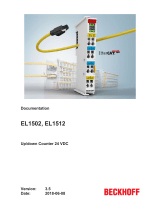 Beckhoff EL1512 Documentation
Beckhoff EL1512 Documentation
-
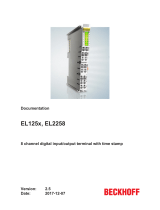 Beckhoff EL2258 Documentation
Beckhoff EL2258 Documentation
-
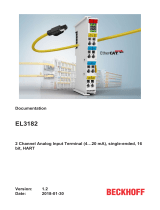 Beckhoff EL3182 Documentation
Beckhoff EL3182 Documentation
-
Beckhoff EtherCAT P Box Quick start guide
-
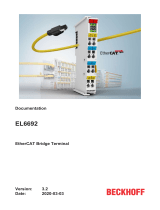 Beckhoff EL6692 Documentation
Beckhoff EL6692 Documentation
-
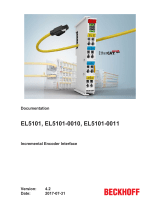 Beckhoff EL5101 Documentation
Beckhoff EL5101 Documentation
-
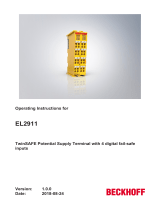 Beckhoff EL2911 Operating Instructions Manual
Beckhoff EL2911 Operating Instructions Manual
-
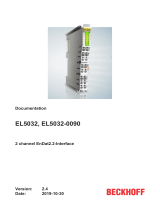 Beckhoff EL5032-0090 Documentation
Beckhoff EL5032-0090 Documentation
-
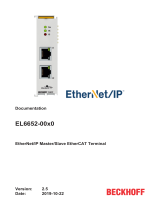 Beckhoff EL6652-00 0 Series Documentation
Beckhoff EL6652-00 0 Series Documentation
-
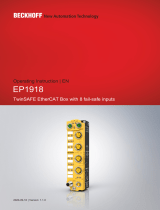 Beckhoff EP1918 Operating
Beckhoff EP1918 Operating
Other documents
-
Xerox DocuColor 2240 Installation guide
-
Tanita Location Code Map Owner's manual
-
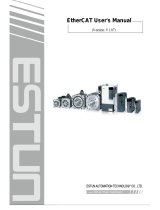 Estun EtherCAT User manual
Estun EtherCAT User manual
-
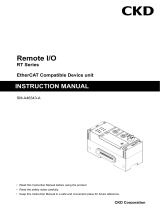 CKD RT Series (EtherCAT) User manual
CKD RT Series (EtherCAT) User manual
-
ABB ESI-S Installation, Operation And Maintenance Instructions
-
ABB ESI-S Installation, Operation And Maintanance Manual
-
ESD CAN-EtherCAT EtherCAT-CAN Gateway Owner's manual
-
ESD EtherCAT-Workbench EtherCAT Network Configuration and Diagnostic Tool Owner's manual
-
IXXAT ETCio 100 Owner's manual
-
WEG SCA06 User guide




















































































































































































































